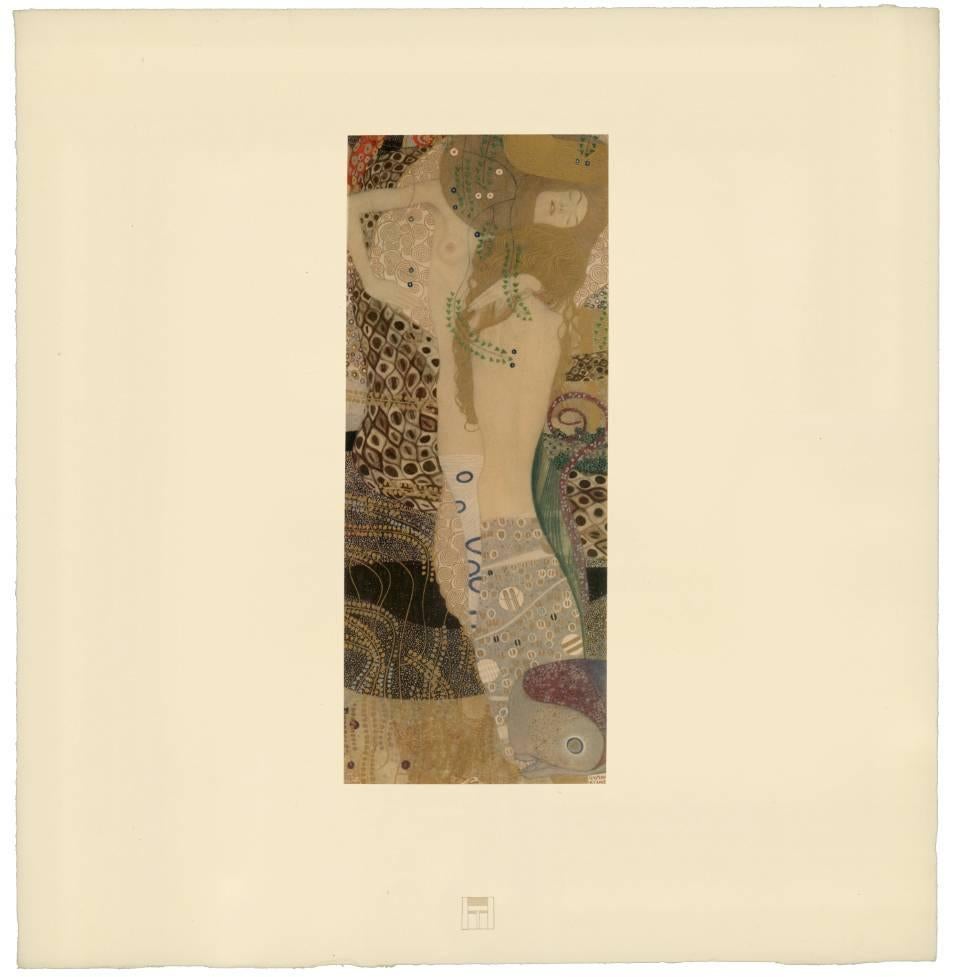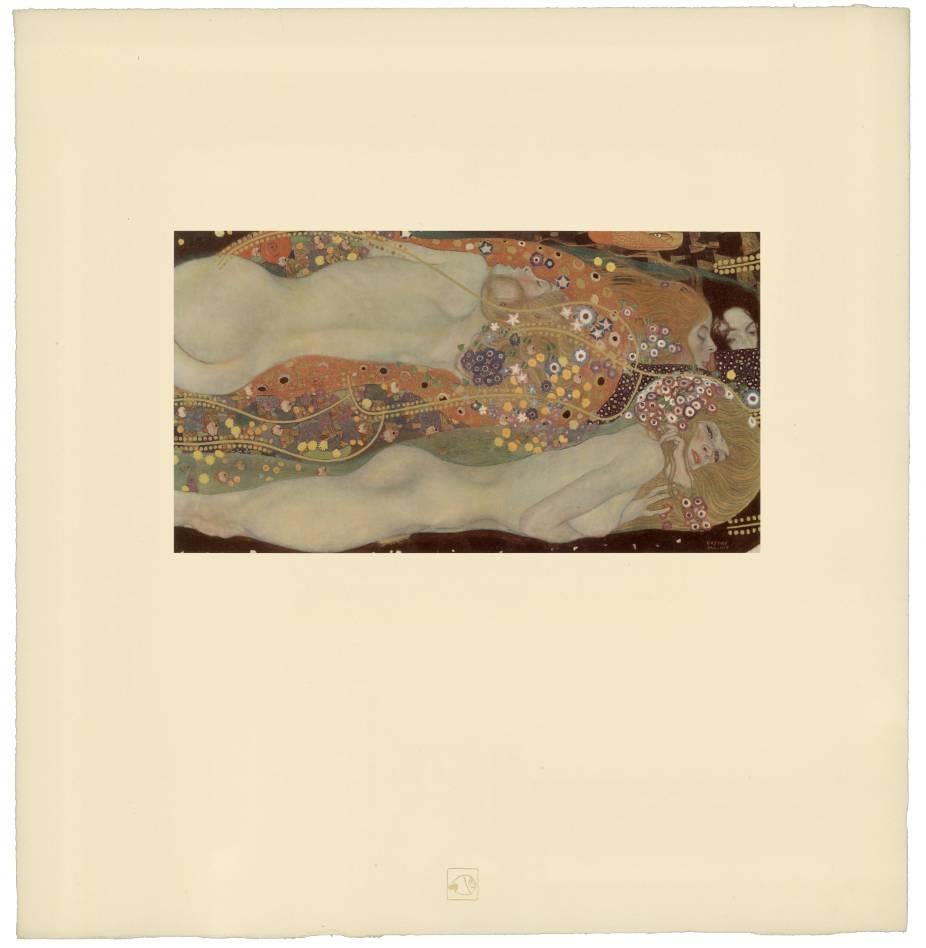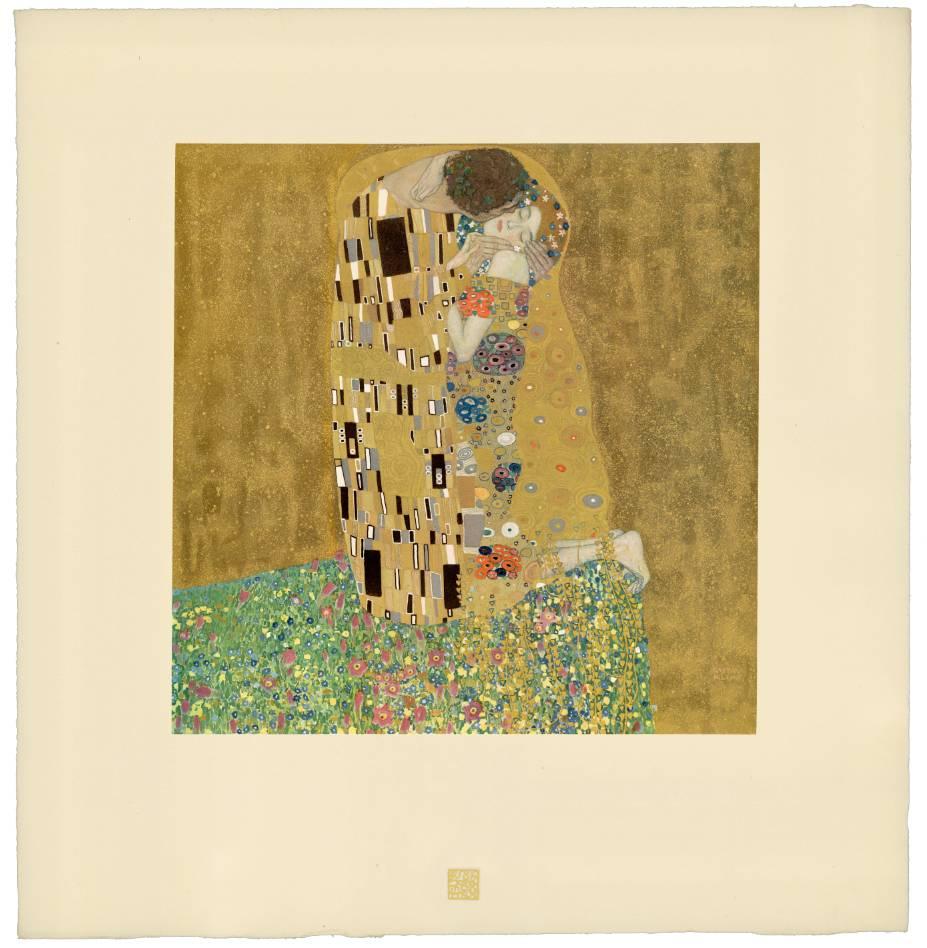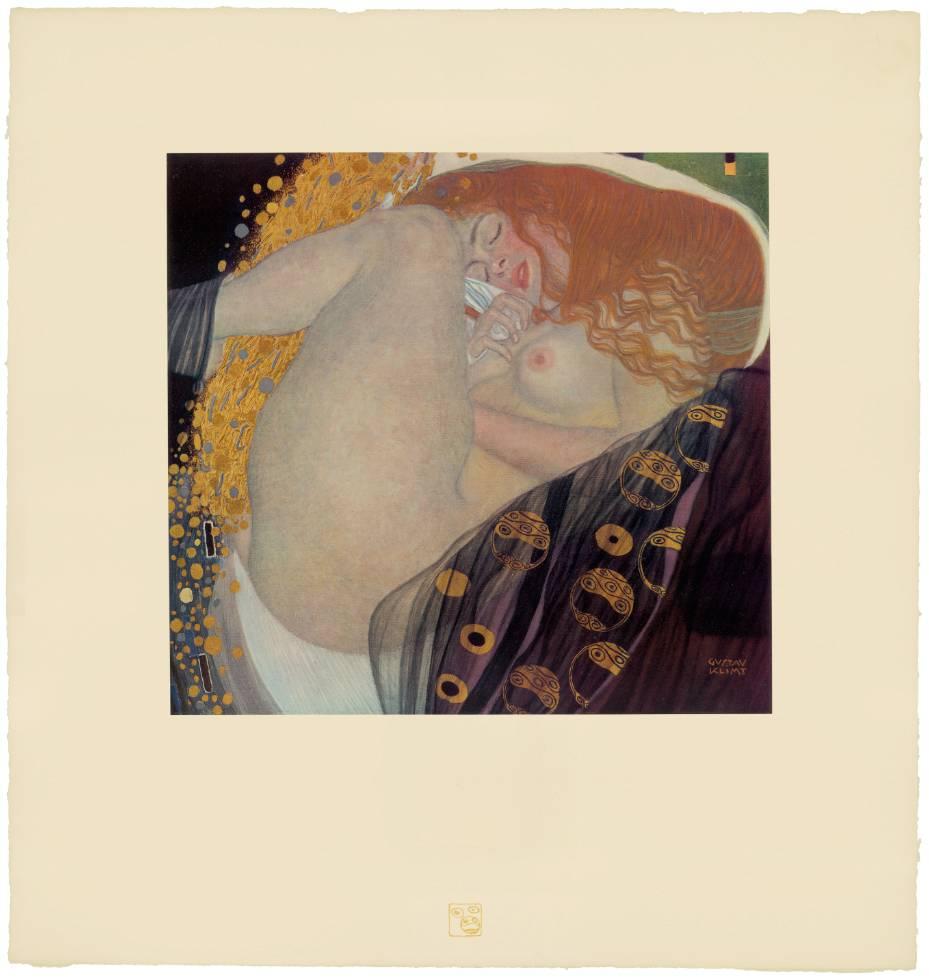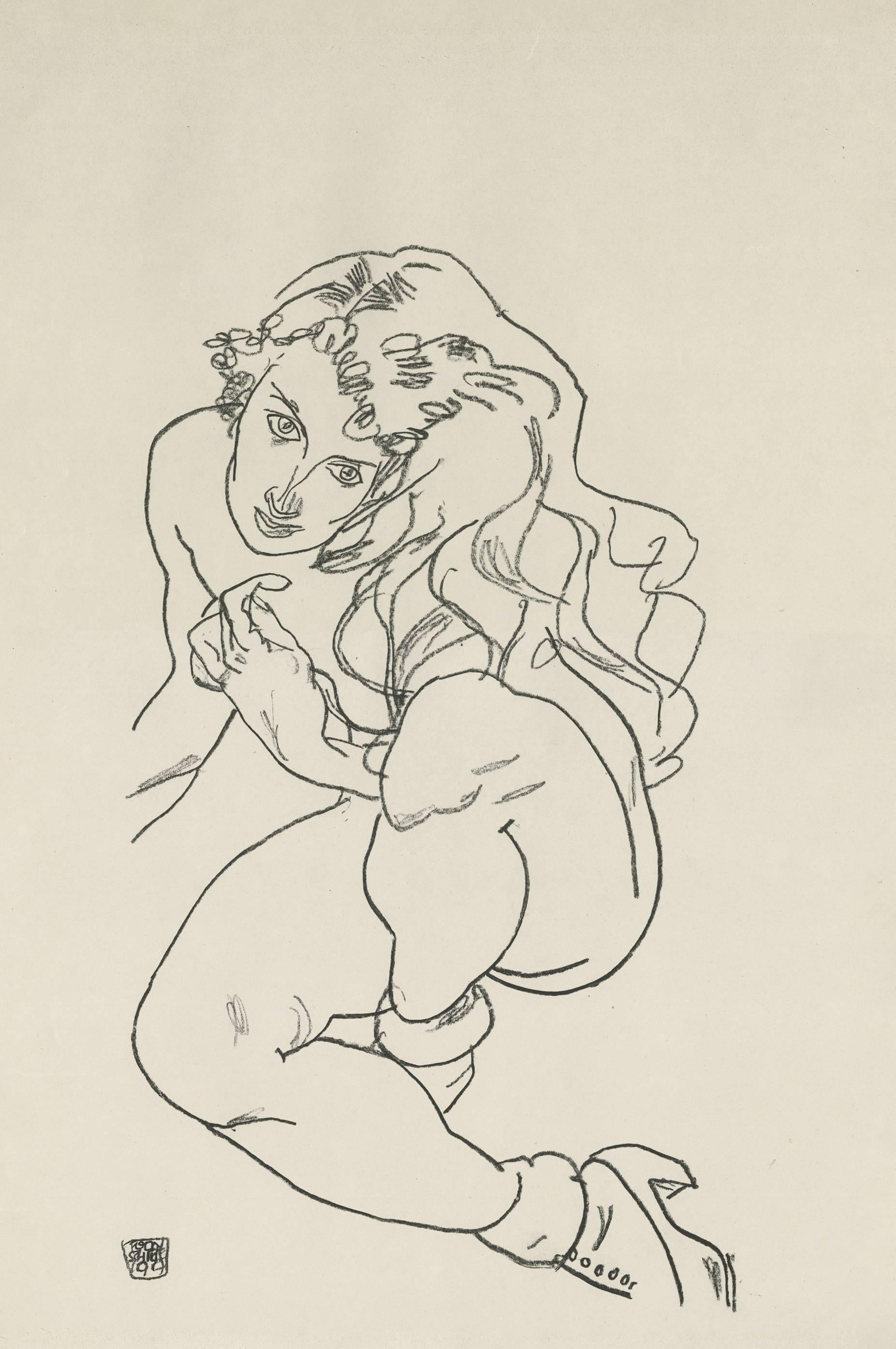Items Similar to Max Eisler Eine Nachlese folio "Portrait of Friederike Marie Beer" collotype
Want more images or videos?
Request additional images or videos from the seller
1 of 6
(after) Gustav KlimtMax Eisler Eine Nachlese folio "Portrait of Friederike Marie Beer" collotype1931
1931
About the Item
After Gustav Klimt, Max Eisler Plate #24, Bildnis Friederike Maria Beer; multi-color collotype after the 1916 painting in oil on canvas.
GUSTAV KLIMT EINE NACHLESE (GUSTAV KLIMT AN AFTERMATH), a portfolio of 30 collotypes prints, 15 are multi-color and 15 are monochrome, on chine colle paper laid down on heavy cream-wove paper with deckled edges; Max Eisler, Editor-Publisher; Osterreichischer Staatsdruckerei (Austrian State Printing Office), Printer; in a limited edition of 500 numbered examples of which: 200 were printed in German, 150 were printed in French and 150 were printed in English; Vienna, 1931.
2018 marks the 100th anniversary of Gustav Klimt’s death. It is a fitting time to reflect upon the enduring legacy and deep impact of his art. Recognizing this need for posterity with uncanny foresight, the publication of Gustav Klimt: An Aftermath (Eine Nachlese) provides a rare collection of work after Klimt which has proven to be an indispensable tool for Klimt scholarship as well as a source for pure visual delight.
Approximately 25 percent of the original works featured in the Aftermath portfolio have since been lost. Of those 30, six were destroyed by fire on 8 May 1945. On that fateful final day of WWII, the retreating Feldherrnhalle, a tank division of the German Army, set fire to the Schloss Immendorf which was a 16th century castle in Lower Austria used between 1942-1945 to store objects of art. All three of Klimt’s Faculty Paintings: Philosophy, Medicine and Jurisprudence (1900-1907), originally created for the University of Vienna, were on premises at that time. Also among the inventory of Klimt paintings in storage there was art which had been confiscated by the Nazis. One of the most significant confiscated collections was the Lederer collection which featured many works by Gustav Klimt such as Girlfriends II and Garden Path with Chickens. In many instances, Aftermath is our only link to these lost treasures.
Max Eisler (1881-1937), the publisher of the 1931 Aftermath portfolio, was an art historian at Vienna University specializing in modern and contemporary arts and crafts whose 1920 book on Klimt was the first Klimt monograph. He saw An Aftermath as filling-in important gaps left by the earlier print portfolios which had only featured Klimt up to 1913 and which had glossed over major art projects such as the Tree of Life frieze for the Palais Stoclet. And whereas only 10 of the 50 prints from the earlier portfolios published by H.O. Miethke were made in intricate multi-color images, Eisler augmented the earlier format by featuring half of the 30 images in stunning multi-colored collotypes. Understanding the fragile nature of the collotype printing process also reinforces this project’s distinctive and exceptional characteristics. Fragile collotype plates can not be reused. As such, this necessitates the completion of a run on the first go and also dictates a limited production number. Printed by hand, the collotypes required deft handling by the printer, Osterreichische Staatsdruckerei. A complicated and lengthy process involving gelatin colloids mixed with dichromates, the creation of 16 color separation thin glass filters to achieve the light-sensitive internegative images which could faithfully capture all of the painting’s tonal gradations and colors, exposure to actinic light, and delicate chine collie papers which allowed for greater color saturation, the printer’s collaborative role in capturing and transmitting Klimt’s nuanced paint strokes is nothing short of remarkable.
The Österreichische Staatsdruckerei (Austrian State Printing Office), was the successor to the KK Hof -und Staatsdruckerei which was founded by Emperor Franz I in 1804 and whose collotype printing innovations of Klimt’s art was first featured in H.O. Miethke’s Das Werk Gustav Klimts portfolios (1908-1913). By 1931, when Max Eisler published Gustav Klimt: An Aftermath, the printer had undergone the name change but had continued its tradition of state-of-the-art collotype art printing.
These multicolored collotype prints are perfect examples of what Klimt referred to as “major art projects.” The very nature of the print medium brings the artist and audience together in a highly accessible way. Each step in the process of their creation required a high level of technical expertise, innovative thinking and true artistic collaboration, Gesamtkunstwerk.
Ever the collaborator, Klimt was the face and voice of many modernist groups and movements: he was President of the Vienna Secession until the split in 1905 when his faction joined forces with the Wiener Werkstaate; he presided over Kunstschau 1908; and he was a founding member of the Austrian Werkbund. Polarizing at times, Klimt’s ability to stimulate discourse and debate during his own lifetime sheds as much light on his social milieu as it does on Klimt, the artist, and his art.
Klimt’s artistic vision extended beyond the studio; he was particularly interested in overcoming the separation between the artist and the consumer. In an effort to bridge that barrier and move towards true unification of artistic experience, Klimt helped develop pioneering art portfolios. In his speech at the opening of Kunstschau 1908, Klimt privileged the role of anyone who sought a relationship with art and declared that contemplation of an artwork was “an act of creative consumption.” Going so far as to radically redefine what it was to be an artist, Klimt expanded Stilkunst to: “interpret the term ‘artist’ just as broadly as the term ‘work of art.’ Not only those who create art are worthy of its name”, Klimt asserted that it encompassed: “all those capable of feeling and of valuing artistic creation.”
Often times criticized for being elitist, the democratizing nature of such a statement is striking. It is an easy leap to see the collaborative possibilities between artists like Klimt and wealthy patrons, such as the Stoclets in Brussels, but it was a radically modernist departure to include anyone as artistic collaborators of the highest merit who cultivated within themselves the capacity to truly engage with art cerebrally and on deeply emotional levels. Reverberations of this call by Klimt still can be heard today. After Klimt’s death, contemporaries like Max Eisler, who was a fellow founding member with Klimt of the Austrian Werkbund, committed themselves to promoting Gesamtkunstwerk by taking up Klimt’s torch which had lit the way for so many. The images captured and preserved for all time in An Aftermath are invitations to recognize the intrinsic value of these works of art, to engage with them, and by doing so, they serve as powerful conduits with which to forge that priceless link to Klimt himself.
- Creator:(after) Gustav Klimt (1862 - 1918, Austrian)
- Creation Year:1931
- Dimensions:Height: 18 in (45.72 cm)Width: 19 in (48.26 cm)
- Medium:
- Movement & Style:
- Period:
- Condition:
- Gallery Location:Chicago, IL
- Reference Number:1stDibs: LU46732710673

About the Seller
5.0
Gold Seller
These expertly vetted sellers are highly rated and consistently exceed customer expectations.
Established in 2013
1stDibs seller since 2016
83 sales on 1stDibs
Typical response time: 2 hours
- ShippingRetrieving quote...Ships From: Chicago, IL
- Return PolicyA return for this item may be initiated within 3 days of delivery.
More From This SellerView All
- H.O. Miethke Das Werk folio "Water Snakes I" collotype printBy Gustav Klimt & K.K. Hof-und StaatsdruckereiLocated in Chicago, ILWater Snakes I, no. 9 from the first installment of Das Werk Gustav Klimts Known by various names, Women Friends, Girlfriends, Water Snakes I and what Kli...Category
Early 1900s Vienna Secession Figurative Prints
MaterialsPaper
- H.O. Miethke Das Werk folio "Judith I" collotype printBy Gustav Klimt & K.K. Hof-und StaatsdruckereiLocated in Chicago, ILJudith I, no. 9 from the second installment of Das Werk Gustav Klimts Much like his treatment of the Classical personage, Danae, from Greek mythology, Klimt’s depiction of Judith takes an Old Testament character, a heroine who avenges the death of her husband by killing an Assyrian king, and firmly positions her in his present-day Vienna. His multicolored collotype rips the canvas from its gilded frame which directly references the subject with its title: “Judith und Holofernes”. Now in print form, Judith, holding the severed head of a male in murky shadow, is the ultimate Viennese femme fatale. Her likeness is unmistakably similar to a former lover of Klimt’s and famous Viennese soprano, Anna von Mildenburg. Though his allusion to ancient Assyria is apt, Klimt literally lifted the gold patterned background’s design motif from a relief detail from Sennacherib’s Palace displayed in a London museum. His context then is contemporary. In a sensual and sexually powerful tour de force, Klimt’s Judith...Category
Early 1900s Vienna Secession Figurative Prints
MaterialsPaper, Ink
- H.O. Miethke Das Werk folio "Water Snakes II" collotype printBy Gustav Klimt & K.K. Hof-und StaatsdruckereiLocated in Chicago, ILWater Snakes II, no. 9 from the fourth installment of Das Werk Gustav Klimts The last painting Klimt exhibited with the Secession before resigning, Water ...Category
Early 1900s Vienna Secession Figurative Prints
MaterialsPaper
- H.O. Miethke Das Werk folio "The Kiss" collotype printBy Gustav Klimt & K.K. Hof-und StaatsdruckereiLocated in Chicago, ILThe Kiss, no. 1 from the fifth installment of Das Werk Gustav Klimts Undoubtedly Klimt’s best known and most reproduced images, this printed version of The Kiss is the only one with which Klimt was directly involved. Unveiled at Vienna’s Kunstschau 1908, and saved for the fifth and final delivery of Das Werk, The Kiss marks a triumph in Klimt’s career and represents a culmination of many themes in his oeuvre up to that point. After all of the controversy surrounding the State’s prior rejection of the University murals commissioned from Klimt, the Ministry of Education reversed their policy toward the artist with a show of wholehearted support by purchasing for the Osterreichische Galerie BelvedereThe Kiss while it still hung in the Kunstschau exhibit. Considered in relation to the eight multicolored collotypes which preceded its print debut in the Das Werk portfolio, The Kiss literally embraces all which came before it. The golden seaweed dangling in tresses from the lovers’ feet harkens back to Water Snakes I and II. The bed of flowers evokes the settings Klimt created in both The Golden Knight and The Sunflower. In fact, this image sprung out of a particularly happy summer spent in the company of Klimt’s lover, Emilie Floge...Category
Early 1900s Vienna Secession Figurative Prints
MaterialsHandmade Paper
- H.O. Miethke Das Werk folio "Danaë" collotype printBy Gustav Klimt & K.K. Hof-und StaatsdruckereiLocated in Chicago, ILDanaë, no. 2 from the fourth installment of Das Werk Gustav Klimts Danae originates from Greek mythology. She is the daughter of the King of Argos. Because a...Category
Early 1900s Vienna Secession Figurative Prints
MaterialsPaper
- E. Strache, Handzeichnungen folio, "Crouching Female Nude" Collotype plate VBy (after) Egon SchieleLocated in Chicago, ILEgon Schiele (1890 – 1918), AUSTRIA “ART CANNOT BE MODERN, ART IS PRIMORDIALLY ETERNAL.” -SCHIELE Defiantly iconoclastic in life and art, Egon Schiele is esteemed for his masterful...Category
1920s Vienna Secession Figurative Prints
MaterialsPaper
You May Also Like
- Original Vintage Secession Poster celebrating the emperor's jubileeLocated in Zurich, CHOriginal Vintage Poster by the Austrian artist Ferdinand Ludwig Graf, a member of the Hagenbund. This Viennese artist association moved as soon a...Category
Early 1900s Vienna Secession Figurative Prints
MaterialsPaper
- JazzyBy Anastasia KurakinaLocated in London, GBartist: Anastasia Kurakina title: “Jazzy” original art print on canvas limited edition, hand signed size: 40x60cm Anastasia Kurakina is an internationally renowned visual artist. To...Category
2010s Vienna Secession Figurative Prints
MaterialsColor, Digital, Canvas
- Of Youth —after Gustav Mahler's 'The Song of the Earth'Located in Myrtle Beach, SCArthur Paunzen, 'Von der Jugend' (Of Youth) from the suite 'Song of the Earth', etching, aquatint, and drypoint, 1920. Signed and titled in pencil. Signed in the plate, lower left. A fine, richly-inked impression, on cream, wove Japan paper; the full sheet with margins (2 1/4 to 4 1/4 inches), in good condition. Image size 12 1/4 x 9 1/16 inches; sheet size 19 3/4 x 13 5/8 inches. Matted to museum standards, unframed. ABOUT THIS WORK Pauzen’s suite of six etchings 'Das Lied von der Erde' (The Song of the Earth), published in 1920, was inspired by Gustav Mahler...Category
1920s Vienna Secession Figurative Prints
MaterialsEtching, Drypoint, Aquatint
- The Drunkard in Spring —after Gustav Mahler's 'The Song of the Earth'Located in Myrtle Beach, SCArthur Paunzen, 'Der Trunkene im Frühling' (The Drunkard in Spring) from the suite 'Song of the Earth', etching, aquatint, and drypoint, 1920. Signed and titled in pencil. Signed in the plate, lower right. A fine, richly-inked impression, on cream, wove Japan paper; the full sheet with margins (2 1/4 to 4 1/4 inches), in good condition. Image size 12 3/8 x 9 1/8 inches; sheet size 19 5/8 x 13 5/8 inches. Matted to museum standards, unframed. ABOUT THIS WORK Pauzen’s suite of six etchings 'Das Lied von der Erde' (The Song of the Earth), published in 1920, was inspired by Gustav Mahler...Category
1920s Vienna Secession Figurative Prints
MaterialsEtching, Drypoint, Aquatint
- The Solitary One in Autumn—after Gustav Mahler's 'The Song of the Earth'Located in Myrtle Beach, SCArthur Paunzen, 'Der Einsame im Herbst' (The Solitary One in Autumn) from the suite 'Song of the Earth', etching, aquatint, and drypoint, 1920. Signed and titled in pencil. Signed in the plate, lower left. A fine, richly-inked impression, on cream, wove Japan paper; the full sheet with margins (2 3/8 to 4 1/8 inches), in good condition. Image size 12 3/8 x 8 7/8 inches; sheet size 19 5/8 x 13 3/4 inches. Matted to museum standards, unframed. ABOUT THIS WORK Pauzen’s suite of six etchings 'Das Lied von der Erde' (The Song of the Earth), published in 1920, was inspired by Gustav Mahler...Category
1920s Vienna Secession Figurative Prints
MaterialsEtching, Drypoint, Aquatint
- POLSTER (The Cushion)By Max KurzweilLocated in Santa Monica, CAMAXIMILLIAN KURZWEIL (Austrian 1867-1916) DER POLSTER / THE CUSHION, 1903. Color woodcut printed on laid japon paper, affixed as usual to a support sheet from its upper sheet edge...Category
Early 1900s Vienna Secession Figurative Prints
MaterialsWoodcut
Recently Viewed
View AllMore Ways To Browse
Collection Of Vintage Tools
Vintage Beer
Fire Tool Set Vintage
Plate Set Portraits
Gustav Klimt Original
Painting After Gustav Klimt
German Beer
Vintage Beer Glasses
1937 German Portrait
Klimt University
Beer Light
Folio 10
Multi Color Storage
Vienna Portrait Plate
Rare Medicine
Vintage Forge Tools
Das Werks
Das Werk
